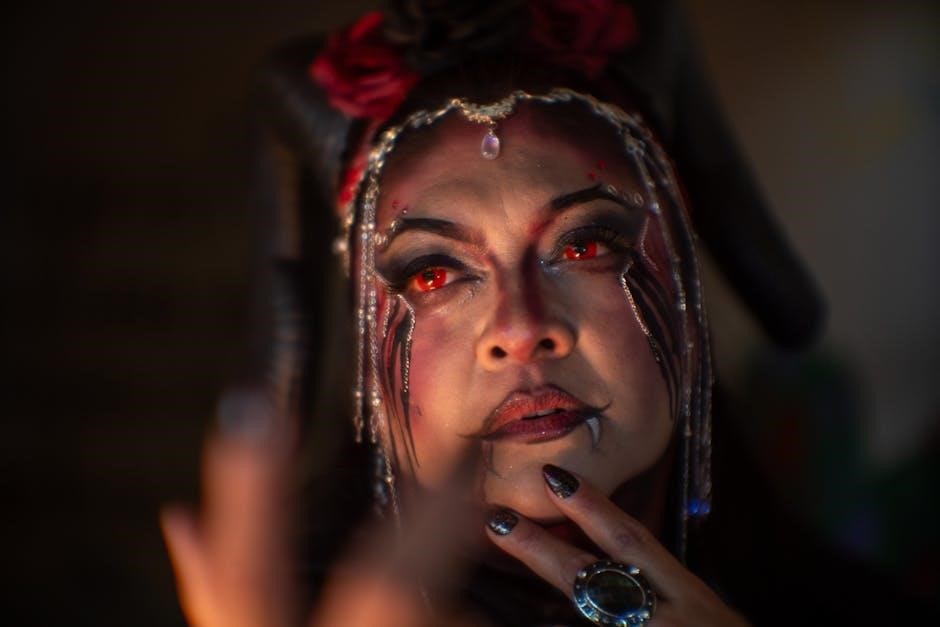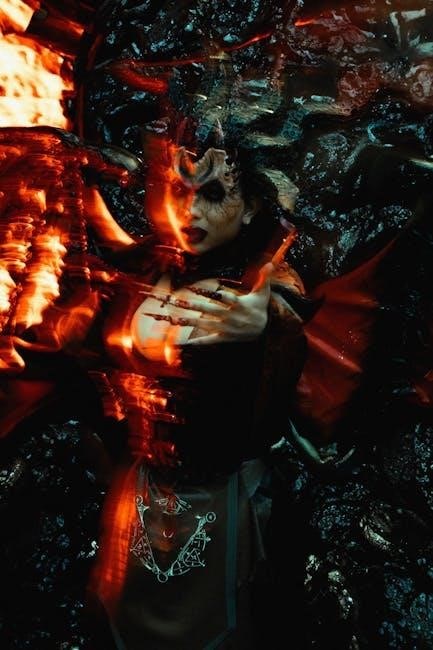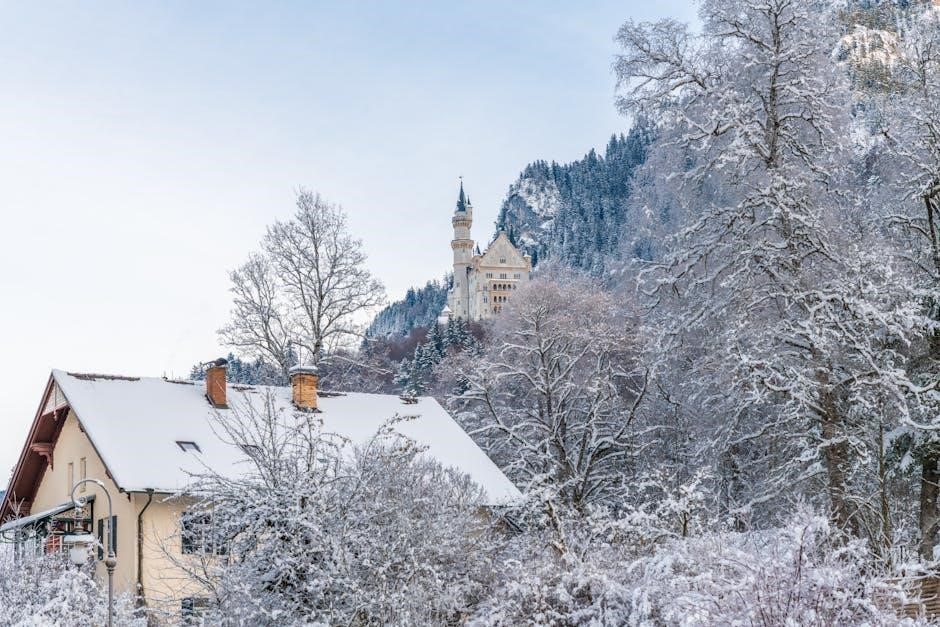The Munich Manual of Demonic Magic is a medieval grimoire primarily composed in Latin focusing on demonic magic and necromancy with sections on conjuration and astrological magic and divination methods available online.
Overview of the Grimoire
The Munich Manual of Demonic Magic is a comprehensive guide to medieval magic, containing a wide range of spells, incantations, and rituals. The grimoire is primarily composed in Latin, with some sections written in other languages. It is a significant example of a medieval manuscript that provides insight into the magical practices of the time. The text is divided into several sections, each focusing on a specific aspect of magic, such as conjuration, divination, and necromancy. The grimoire also contains illustrations and diagrams that accompany the text, providing a visual representation of the magical rituals and spells. The Munich Manual of Demonic Magic is a valuable resource for historians and scholars of medieval magic, offering a unique glimpse into the beliefs and practices of medieval society. The grimoire’s contents are diverse, ranging from simple spells to complex ceremonies, making it a fascinating example of medieval magical literature. Overall, the Munich Manual of Demonic Magic is an important and intriguing example of a medieval grimoire.
Historical Context
The Munich Manual of Demonic Magic was written in the 15th century, a time of great social and cultural change in Europe. The manuscript is a product of the medieval period, when magic and superstition were widespread. The text reflects the fears and anxieties of the time, with its focus on demonic magic and necromancy. The grimoire was likely written by a cleric or a member of the nobility, who had access to education and literary resources. The historical context of the manuscript is significant, as it provides insight into the beliefs and practices of medieval society. The Munich Manual of Demonic Magic is a window into the past, offering a glimpse of the magical and spiritual practices of the time. The manuscript has been preserved for centuries, and its discovery has shed new light on the history of magic and the occult. The historical context of the grimoire is complex and multifaceted, reflecting the cultural and social nuances of the medieval period. The manuscript’s history is a fascinating topic, and its study has contributed significantly to our understanding of medieval magic.

Structure and Content
The manual contains various sections and chapters with detailed descriptions of magical rituals online resources.
Types of Magic Covered

The Munich Manual of Demonic Magic covers a range of magical practices, including demonic and necromantic magic, which involve summoning and commanding demons and spirits of the dead. The manual also explores astrological magic, which utilizes the positions of celestial bodies to influence magical outcomes. Additionally, the text delves into divination methods, such as reading omens and interpreting dreams, to gain insight into future events. The manual’s coverage of illusionist magic allows practitioners to create elaborate deceptions and spectacles, while its discussion of psychological magic enables them to influence the thoughts and actions of others. Overall, the Munich Manual of Demonic Magic provides a comprehensive guide to various forms of magic, catering to the interests of medieval practitioners and modern enthusiasts alike. The manual’s diverse range of magical topics has contributed to its enduring popularity and influence in the realm of occult studies. The text remains a valuable resource for those seeking to understand the complexities of medieval magic and its ongoing impact on contemporary esoteric traditions. The manual’s magical teachings continue to fascinate readers and inspire new generations of practitioners.
Rituals and Incantations
The Munich Manual of Demonic Magic contains a collection of rituals and incantations designed to summon and command demons, as well as to achieve various magical goals. These rituals range from simple spells and prayers to complex ceremonies, often involving the use of magical tools and sacred symbols. The manual provides detailed instructions for performing these rituals, including the necessary words, gestures, and offerings to be made to the demons. The incantations themselves are often written in Latin, and are intended to be recited with great solemnity and reverence. The rituals and incantations in the manual are designed to be used in conjunction with one another, allowing practitioners to create complex and powerful magical workings. By following the instructions provided in the manual, practitioners can allegedly gain supernatural powers and knowledge, as well as communicate with a variety of demonic entities. The manual’s rituals and incantations remain a fascinating and somewhat unsettling aspect of medieval magical practice. The use of these rituals and incantations continues to be studied by historians and enthusiasts of the occult.

Significance and Influence
The manual has significant historical influence on medieval occultism and demonology practices online.
Editorial History

The Munich Manual of Demonic Magic has a complex editorial history, with various scholars contributing to its translation and interpretation over the years. One notable edition was published by Richard Kieckhefer in 1998, under the title Forbidden Rites: A Necromancer’s Manual. This edition provided a comprehensive translation of the original Latin text, along with commentary and analysis. The editorial history of the manual is significant, as it reflects the evolving understanding of medieval occultism and demonology. The publication of the manual has also sparked debate among scholars, with some arguing that it represents a genuine medieval grimoire, while others see it as a later compilation of various magical texts. Despite these debates, the Munich Manual of Demonic Magic remains an important source for understanding the history of occultism and demonology in medieval Europe. The manual’s editorial history continues to be studied by scholars, who seek to uncover the secrets of this enigmatic text.
Modern Relevance
The Munich Manual of Demonic Magic remains a topic of interest in modern times, with many people fascinated by its dark and mysterious contents. The manual’s focus on demonic magic and necromancy continues to captivate audiences, inspiring numerous books, films, and other works of fiction. In addition, the manual’s historical significance has led to its inclusion in various academic studies, exploring the cultural and social context of medieval occultism. Many modern occultists and practitioners of magic also draw inspiration from the manual, incorporating its rituals and incantations into their own practices. The internet has further increased the manual’s accessibility, allowing people to explore its contents and discuss its significance online. As a result, the Munich Manual of Demonic Magic has become a cultural touchstone, symbolizing the darker aspects of human nature and the ongoing fascination with the supernatural. Its modern relevance is a testament to the enduring power of medieval occultism to captivate and inspire people. The manual’s influence can be seen in many areas of modern culture, from fiction to fashion.
The Munich Manual of Demonic Magic concludes as a historical grimoire with significant cultural impact and influence on modern occultism and supernatural studies available online today everywhere.
Final Thoughts
The Munich Manual of Demonic Magic is a complex and intriguing text that offers a unique glimpse into the world of medieval occultism. The manual’s focus on demonic magic and necromancy has led to its classification as a grimoire, a type of textbook used by magicians and occultists to invoke and control supernatural entities. As a historical artifact, the Munich Manual provides valuable insights into the beliefs, practices, and superstitions of the medieval period. Its significance extends beyond its historical context, as it continues to influence modern occultism and supernatural studies. The manual’s contents, including its rituals, incantations, and conjurations, have been the subject of much fascination and debate. Overall, the Munich Manual of Demonic Magic is a fascinating and enigmatic text that continues to captivate scholars, occultists, and enthusiasts of the supernatural. Its study and analysis offer a unique perspective on the development of Western occultism and the evolution of magical practices over time; The manual’s influence can be seen in many areas of modern culture.
Future Research
Further study of the Munich Manual of Demonic Magic is necessary to fully understand its significance and influence on Western occultism. Researchers should investigate the manual’s historical context, examining the social, cultural, and religious factors that contributed to its creation. A comparative analysis of the manual with other grimoires and occult texts could provide valuable insights into the development of magical practices during the medieval period; Additionally, scholars should explore the manual’s impact on modern occultism, examining how its rituals and incantations have been adapted and modified over time. The use of digital humanities tools and methods could facilitate a more detailed analysis of the manual’s contents, allowing researchers to identify patterns and themes that may have been previously overlooked. By pursuing these avenues of research, scholars can gain a deeper understanding of the Munich Manual of Demonic Magic and its place within the broader history of Western occultism. This research has the potential to shed new light on the development of magical practices and the evolution of supernatural beliefs. New discoveries may also be made, adding to our knowledge of this fascinating topic.
